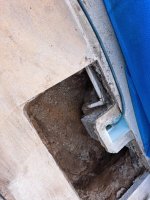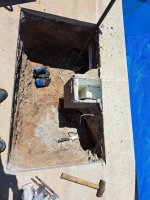That looks like it could have been snaked at a time just by the way the copper is pushed out sort of poked out from the inside.
Help I think my pool is leaking!
- Thread starter CaChris
- Start date
You are using an out of date browser. It may not display this or other websites correctly.
You should upgrade or use an alternative browser.
You should upgrade or use an alternative browser.
Pool_Medic
In The Industry
Bill1974
Well-known member
- Jun 18, 2014
- 602
- Pool Size
- 32000
- Surface
- Vinyl
- Chlorine
- Salt Water Generator
- SWG Type
- CircuPool RJ-60 Plus
I would not trust this bucket test. Concrete is like a sponge. If that paver was not saturated before this test was started it's going to absorb water and make it look like the level in the bucket dropped more and make you think you have a lot of evaporation.The bucket on the inside lost about half an inch and the outside of the bucket lost about an inch and a half from yesterday.
View attachment 563318
Bill1974
Well-known member
- Jun 18, 2014
- 602
- Pool Size
- 32000
- Surface
- Vinyl
- Chlorine
- Salt Water Generator
- SWG Type
- CircuPool RJ-60 Plus
Kudos for diying this project. I did this on my steel wall in ground pool, I can imagine how much more work it is dealing with concrete. Surprised to see copper, my pool is from a similar era (it's had a couple of sets of black poly line and a couple of sets flexible PVC and I replaced it all with rigid PVC). Copper is pretty easily corroded away in a chlorine pool. I would be concerned that all the copper lines would be in similar shape. You may want to pressure test all your lines to see if you have more leaks.
Might look like that from the picture.But if you put your hand over the hole and feel where the water is coming out it's actually smooth.That looks like it could have been snaked at a time just by the way the copper is pushed out sort of poked out from the inside.
This was just a quick test to see if the water level outside the bucket was dropping faster than the water level inside the bucket.I would not trust this bucket test. Concrete is like a sponge. If that paver was not saturated before this test was started it's going to absorb water and make it look like the level in the bucket dropped more and make you think you have a lot of evaporation.
The concrete might have absorbed some but since I lost so much water on the outside of the bucket kinda proved that the pool was leaking.
Wish I could unfortunately most of the pool's lines whether it's return or intake are all copper. What's weird is the skimmer is copper then it transitions into p, v, c, but somewhere underneath the slab.It transitions back to copper and comes up at my pump.I’d definitely cut out all that copper.
The leak detection company tested every line except for the very bottom of the pool and I think they could not test that because the skimmer was not holding pressure.Kudos for diying this project. I did this on my steel wall in ground pool, I can imagine how much more work it is dealing with concrete. Surprised to see copper, my pool is from a similar era (it's had a couple of sets of black poly line and a couple of sets flexible PVC and I replaced it all with rigid PVC). Copper is pretty easily corroded away in a chlorine pool. I would be concerned that all the copper lines would be in similar shape. You may want to pressure test all your lines to see if you have more leaks.
tstex
Silver Supporter
This might be where the copper pipe was leaking previously and the plumber went with a PVC fix, then transitioned back to the original copper.Wish I could unfortunately most of the pool's lines whether it's return or intake are all copper. What's weird is the skimmer is copper then it transitions into p, v, c, but somewhere underneath the slab.It transitions back to copper and comes up at my pump.
Like recommended, I would pressure test everything before you start to fill your hole. I would initially go w a low PSI and work up to no more than what the max PSI your filter pump produces. The last thing you want is to break some other lines. If 80's, those copper lines are 40+ yrs old. Buried and with CL running thru them, I can see why it pin-holed. In fact, you might want to operate your pool for a week or so as is before you fill the hole. Just to be on the same side to insure your fix lasts....
Finally, as stated, that's a lot of work. I helped an elderly man in my church by fixing a leaking PVC pipe. It was A LOT of work but noting like your depth. Hope that copper holds up for yrs to come. good luck, tstex
Bill1974
Well-known member
- Jun 18, 2014
- 602
- Pool Size
- 32000
- Surface
- Vinyl
- Chlorine
- Salt Water Generator
- SWG Type
- CircuPool RJ-60 Plus
Thinking about your leak and my own past leak experiences. I don't have a warm fuzzy feeling that this is the only leak. For such a small hole and on the suction line I am a bit surprised the water dropped as much as it did in the time you noted. If it were on the return side I think I the water loss rate would make more sense.
Like mentioned above don't go overboard when pressure testing. But I would not be overly concerned. Every time your pump starts there a pressure spike above what it normally runs at. Also don't jump to conclusions when your first pressure test fails, I always seem to have a leak at a plug or something else the first test.
Like mentioned above don't go overboard when pressure testing. But I would not be overly concerned. Every time your pump starts there a pressure spike above what it normally runs at. Also don't jump to conclusions when your first pressure test fails, I always seem to have a leak at a plug or something else the first test.
They tested all the lines except the main drain line, so I hope I'm good for awhile with those lines. The water level has stop going down, now that it is below the skimmer leak.This might be where the copper pipe was leaking previously and the plumber went with a PVC fix, then transitioned back to the original copper.
Like recommended, I would pressure test everything before you start to fill your hole. I would initially go w a low PSI and work up to no more than what the max PSI your filter pump produces. The last thing you want is to break some other lines. If 80's, those copper lines are 40+ yrs old. Buried and with CL running thru them, I can see why it pin-holed. In fact, you might want to operate your pool for a week or so as is before you fill the hole. Just to be on the same side to insure your fix lasts....
Finally, as stated, that's a lot of work. I helped an elderly man in my church by fixing a leaking PVC pipe. It was A LOT of work but noting like your depth. Hope that copper holds up for yrs to come. good luck, tstex
I would have thought the same, but we are in a very sandy soil. I think when they did the pressure testing it opened up the hole a bit or more likely blew out some dirt that was plugging the hole. Water loss increased after the pressure testing.Thinking about your leak and my own past leak experiences. I don't have a warm fuzzy feeling that this is the only leak. For such a small hole and on the suction line I am a bit surprised the water dropped as much as it did in the time you noted. If it were on the return side I think I the water loss rate would make more sense.
Like mentioned above don't go overboard when pressure testing. But I would not be overly concerned. Every time your pump starts there a pressure spike above what it normally runs at. Also don't jump to conclusions when your first pressure test fails, I always seem to have a leak at a plug or something else the first test.
Okay so it's finally done. I completed the project, it took me a long time but it's now done. I will update some pictures, so other people that are going to tackle this project and see how it was done. N
 ot sure if I did it right but it's all working as of now.
ot sure if I did it right but it's all working as of now.
Attachments
I'm having a hard time uploading photos of the project if anybody is trying to tackle this and they want help, just go ahead and email me or message me on this or on this website and I'll get back to you. Mentally it's very easy but physically it's a very hard job as I had to Jack hammer out about a thousand pounds of concrete and I entombed the new skimmer with 720 lb of concrete, ish.
Bill1974
Well-known member
- Jun 18, 2014
- 602
- Pool Size
- 32000
- Surface
- Vinyl
- Chlorine
- Salt Water Generator
- SWG Type
- CircuPool RJ-60 Plus
Nice job. It's always a bit daunting doing something like this for the first time. Now you can enjoy your pool.
Thread Status
Hello , This thread has been inactive for over 60 days. New postings here are unlikely to be seen or responded to by other members. For better visibility, consider Starting A New Thread.




